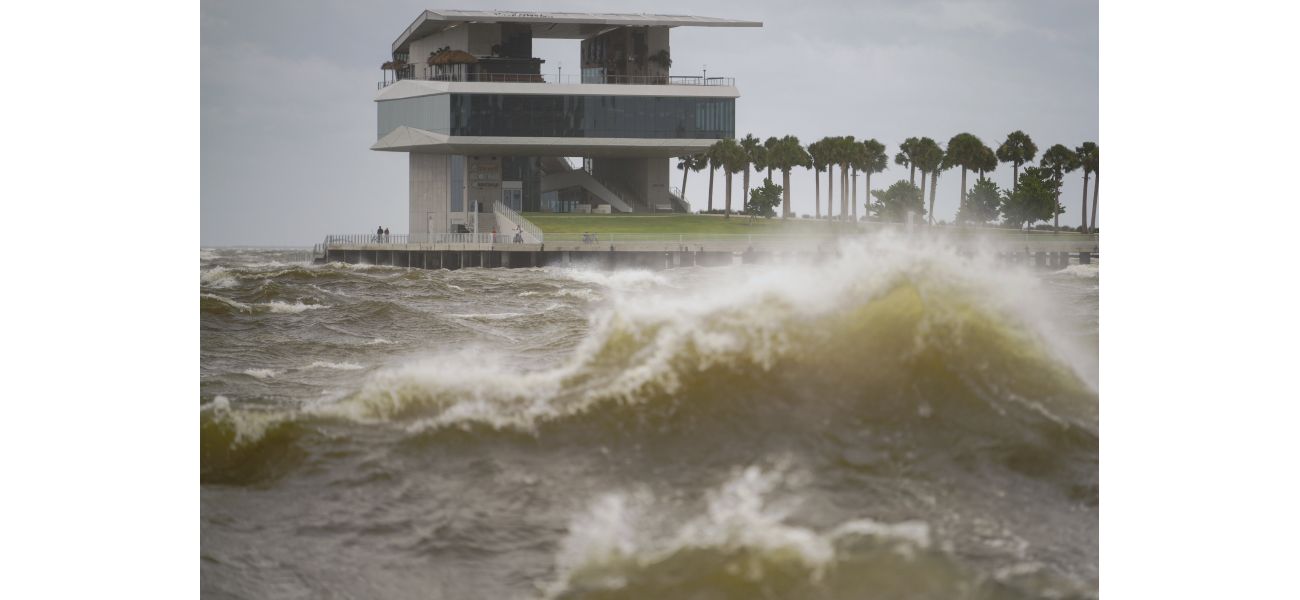A powerful Category 4 hurricane, Helene, hits northwestern Florida.
Power outages have affected over 250,000 homes due to strong winds, prompting emergency declarations in multiple states.
September 27th 2024.

On a Thursday evening, Hurricane Helene, a fast-moving Category 4 storm, reached the Big Bend area of Florida's northwestern coast. The storm's arrival threatened to bring a catastrophic storm surge, damaging winds, heavy rains, and flash floods to the southeastern United States, extending hundreds of miles inland. According to forecasters, this could have a devastating impact on the region.
As Helene approached, authorities in Georgia reported two deaths that may have been caused by a tornado. In addition, Florida Governor Ron DeSantis announced that one person had died while driving on Interstate 4 when a sign collapsed onto their car. The storm's powerful winds also caused power outages, affecting over 1 million homes and businesses in Florida and 50,000 in Georgia, according to the tracking site poweroutage.us.
The potential for destruction led several states, including Florida, Georgia, the Carolinas, Virginia, and Alabama, to declare a state of emergency. Meanwhile, in the Pacific, former Hurricane John regained strength and became a hurricane once again, posing a threat to Mexico's western coast with flash floods and mudslides. On the other side of the Atlantic, Tropical Storm Isaac formed on Wednesday and is expected to strengthen as it moves east, possibly becoming a hurricane by the end of the week.
Governor DeSantis expressed his concern for the safety of Floridians, urging them to stay indoors and take necessary precautions. He also announced that 3,500 National Guardsmen were on standby to assist with the aftermath of the storm. With more fatalities and property damage expected, DeSantis asked for prayers for those affected by Helene.
The National Hurricane Centre in Miami reported that Hurricane Helene made landfall near Perry, Florida, in the Big Bend area, with maximum sustained winds of 140 mph. The storm brought with it the potential for catastrophic flooding, especially in Florida's Apalachee Bay, where storm surges of up to 20 feet were forecasted. Hurricane and flash flood warnings extended beyond the coast, reaching northern Georgia and western North Carolina.
The power outages caused by Helene continued to rise, with over 885,000 customers in Florida without electricity as of 11 p.m. EDT. The majority of these outages were concentrated in the Big Bend area, where the storm was expected to make landfall.
In the meantime, the former Hurricane John was downgraded to a tropical storm as it moved slowly along the coast of the Mexican state of Michoacan. However, it still posed a threat as it sustained winds of 70 mph and could cause severe flash flooding. John first hit Mexico on Monday night as a Category 3 hurricane, causing significant damage before weakening inland. It then regained strength and became a hurricane again on Thursday.
The National Hurricane Centre reported that John is expected to weaken further on Thursday night and into Friday. However, the storm's impact has already been felt, with roofs blown off houses, mudslides, and fallen trees causing chaos in its path. As the storm continues to move along the coast, the potential for further destruction remains a concern.
Hurricane Helene, a fast-moving Category 4 storm, made its way onto Florida's northwestern coast on Thursday evening. The powerful storm brought with it the potential for catastrophic storm surge, strong winds, heavy rains, and flash floods across a wide area of the southeastern United States. As Hurricane Helene approached, authorities in Georgia reported two fatalities possibly caused by a tornado, and Florida Governor Ron DeSantis confirmed one death from a falling sign on Interstate 4.
The storm left over 1 million homes and businesses without power in Florida and over 50,000 in Georgia. States of emergency were declared in Florida, Georgia, the Carolinas, Virginia, and Alabama. Meanwhile, in the Pacific, former Hurricane John regained strength and was once again classified as a hurricane as it threatened the western coast of Mexico with potential flash flooding and mudslides. However, it was later downgraded to a tropical storm as it moved along the coast of Michoacan.
At a news conference, Governor DeSantis urged residents to stay safe and be aware of the dangerous conditions. He also warned that there may be more fatalities as the storm progresses and that 3,500 National Guardsmen were ready to respond. He asked for prayers for those who have lost their lives and homes due to the storm.
Hurricane Helene made landfall near Perry, Florida, in the Big Bend area with maximum sustained winds of 140 mph. The National Hurricane Centre in Miami issued warnings for potential storm surges of up to 20 feet in Florida's Apalachee Bay, which could be catastrophic and unsurvivable. The hurricane and flash flood warnings extended beyond the coast, reaching as far as northern Georgia and western North Carolina.
As of 11 p.m. EDT, over 885,000 customers in Florida were without power, with many counties in the Big Bend area experiencing widespread outages. In Mexico, former Hurricane John was downgraded to a tropical storm as it slowly moved along the coast of Michoacan. However, it still posed a threat of severe flash flooding, with sustained wind speeds of 70 mph. The storm initially made landfall as a Category 3 hurricane in Acapulco, causing damage and destruction before weakening and then reforming as a tropical storm. The hurricane centre predicted that the storm would continue to weaken as it moved into Thursday night and Friday.
As Helene approached, authorities in Georgia reported two deaths that may have been caused by a tornado. In addition, Florida Governor Ron DeSantis announced that one person had died while driving on Interstate 4 when a sign collapsed onto their car. The storm's powerful winds also caused power outages, affecting over 1 million homes and businesses in Florida and 50,000 in Georgia, according to the tracking site poweroutage.us.
The potential for destruction led several states, including Florida, Georgia, the Carolinas, Virginia, and Alabama, to declare a state of emergency. Meanwhile, in the Pacific, former Hurricane John regained strength and became a hurricane once again, posing a threat to Mexico's western coast with flash floods and mudslides. On the other side of the Atlantic, Tropical Storm Isaac formed on Wednesday and is expected to strengthen as it moves east, possibly becoming a hurricane by the end of the week.
Governor DeSantis expressed his concern for the safety of Floridians, urging them to stay indoors and take necessary precautions. He also announced that 3,500 National Guardsmen were on standby to assist with the aftermath of the storm. With more fatalities and property damage expected, DeSantis asked for prayers for those affected by Helene.
The National Hurricane Centre in Miami reported that Hurricane Helene made landfall near Perry, Florida, in the Big Bend area, with maximum sustained winds of 140 mph. The storm brought with it the potential for catastrophic flooding, especially in Florida's Apalachee Bay, where storm surges of up to 20 feet were forecasted. Hurricane and flash flood warnings extended beyond the coast, reaching northern Georgia and western North Carolina.
The power outages caused by Helene continued to rise, with over 885,000 customers in Florida without electricity as of 11 p.m. EDT. The majority of these outages were concentrated in the Big Bend area, where the storm was expected to make landfall.
In the meantime, the former Hurricane John was downgraded to a tropical storm as it moved slowly along the coast of the Mexican state of Michoacan. However, it still posed a threat as it sustained winds of 70 mph and could cause severe flash flooding. John first hit Mexico on Monday night as a Category 3 hurricane, causing significant damage before weakening inland. It then regained strength and became a hurricane again on Thursday.
The National Hurricane Centre reported that John is expected to weaken further on Thursday night and into Friday. However, the storm's impact has already been felt, with roofs blown off houses, mudslides, and fallen trees causing chaos in its path. As the storm continues to move along the coast, the potential for further destruction remains a concern.
Hurricane Helene, a fast-moving Category 4 storm, made its way onto Florida's northwestern coast on Thursday evening. The powerful storm brought with it the potential for catastrophic storm surge, strong winds, heavy rains, and flash floods across a wide area of the southeastern United States. As Hurricane Helene approached, authorities in Georgia reported two fatalities possibly caused by a tornado, and Florida Governor Ron DeSantis confirmed one death from a falling sign on Interstate 4.
The storm left over 1 million homes and businesses without power in Florida and over 50,000 in Georgia. States of emergency were declared in Florida, Georgia, the Carolinas, Virginia, and Alabama. Meanwhile, in the Pacific, former Hurricane John regained strength and was once again classified as a hurricane as it threatened the western coast of Mexico with potential flash flooding and mudslides. However, it was later downgraded to a tropical storm as it moved along the coast of Michoacan.
At a news conference, Governor DeSantis urged residents to stay safe and be aware of the dangerous conditions. He also warned that there may be more fatalities as the storm progresses and that 3,500 National Guardsmen were ready to respond. He asked for prayers for those who have lost their lives and homes due to the storm.
Hurricane Helene made landfall near Perry, Florida, in the Big Bend area with maximum sustained winds of 140 mph. The National Hurricane Centre in Miami issued warnings for potential storm surges of up to 20 feet in Florida's Apalachee Bay, which could be catastrophic and unsurvivable. The hurricane and flash flood warnings extended beyond the coast, reaching as far as northern Georgia and western North Carolina.
As of 11 p.m. EDT, over 885,000 customers in Florida were without power, with many counties in the Big Bend area experiencing widespread outages. In Mexico, former Hurricane John was downgraded to a tropical storm as it slowly moved along the coast of Michoacan. However, it still posed a threat of severe flash flooding, with sustained wind speeds of 70 mph. The storm initially made landfall as a Category 3 hurricane in Acapulco, causing damage and destruction before weakening and then reforming as a tropical storm. The hurricane centre predicted that the storm would continue to weaken as it moved into Thursday night and Friday.
[This article has been trending online recently and has been generated with AI. Your feed is customized.]
[Generative AI is experimental.]
0
0
Submit Comment





